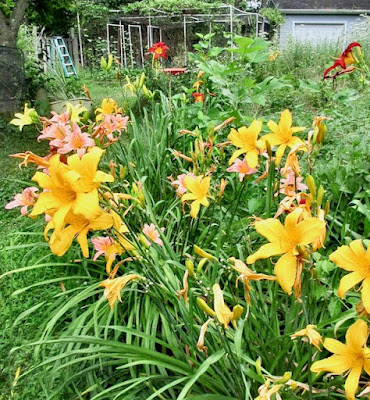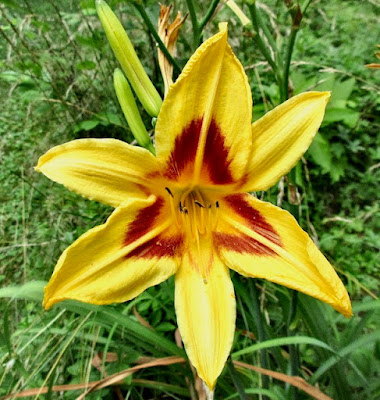1. Well, it seems I can finally plant my tomato seedlings outside today. Mid-April was warm and the forecasts suggested it would stay that way but weather has been more variable the past decade and the Washington DC area is historically difficult anyway.
Not to get into details about that, but basically DC is at the border between the last cold fronts from Canada and the early warm fronts from the Gulf with some swirling winds through the gaps in the Appalachian Mountains.
Really mixes things around. A night with an expected low of 50 suddenly drops to 40. But it looks like the Gulf fronts have won and the lows will stay at 60 minimum. Not much a difference to we humans in our homes, but it sure matters to a tomato seedling.
Tomatoes are actually semi-tropical plants. And below about 55, they don't do well. They can get permanently set back in growth and production. Ever read that you shouldn't refrigerate tomatoes? That's why. It shuts down their enzymes and that's where the flavor is. And as seedlings, they don't recover. Oh, I don't mean they die; they just don't thrive.
I used to try all sorts of things to plant tomato seedling outside early. Black plastic on the raised beds to warm the soil. Surrounding the seedlings with plastic tubes of water

The idea is that the water warms in the daytime sun and keeps the seedling warm through the night. It's a pain. Each tube has to be filled individually and then after a day of warming the water, you have to plant the seedling down through the top.
I did that for 20 years, thinking I was getting a good head start on my planting and would get a nice ripe heirloom tomato a couple of weeks earlier. I adore heirloom tomatoes!
Then, one year, I did that for half the tomatoes and delayed planting the other half until the soil warmed above 55. The tomatoes planted later did better than the earlier ones... Lesson? You can't really warm the soil before Mother Nature does it herself!
Waiting 3 weeks until the time is actually right to plant beats trying to get around the natural course of the seasons.
2. For different reasons (Aphids and Fungus Gnats) I think I will give up trying to grow lettuces under lights in the basement. In the basement, they have no natural predators (other than me) and they multiply faster than I can manage.
I try to stay organic and the best organic controls are Neem (a tree bark product) Safer's soap (soap dehydrates insects and plants don't mind mild soap much), and yellow sticky-paper (yellow attracts them and they can't get loose when the land. I had a dozen 3"x5" of those around my basement lettuce and pak choy. I lost the entire crop twice last Winter.
I'm not exaggerating when I say I caught 1,000 of them on the sticky paper. But there is no end to them! There are always a few who escape and lay 1000s of eggs in the soil and then "there we go again".
And that's just one sticky paper!
I have the trays replanted out on the deck. I never see a ladybug of other predatory insect there, but I don't see any aphids either. But the lettuces are growing nicely and I'll replant the Pak choy soon. I cut the celery down to an inch and they are growing new stalks quickly. The Red leaf lettuce is doing especially well, but I don't have a picture (it was all blurry). So here is last year and they are all doing about as well.

3. I planted a dozen snow peas behind a trellis 3 weeks ago. 9 came up. So I decided to plant more in front and fill in the missing back ones. I soak the seeds overnight and then fold them in a damp paper towel in a plastic bag. Most germinate and that lets you know which to plant.
Planting dry peas gets me about 50% seedlings. Planting pre-germinated peas gets me about 80% seedlings. BTW, the pea trellis is 6' wide in the middle of a 10' wide raised box. So I'll be planting two grids of corn on either side (both bicolor, but one early-maturing and one later). And I will soak the corn overnight too. That helps. But I don't have to wait to see a root. The soaking itself is sufficient for corn.
4. I have actual meadow flowers finally growing in my 4 year old meadow bed! I knew they tended to take a couple years to establish good roots, but I was beginning to worry. But suddenly this year they are growing upwards fast. I know which ones they are because I stuck the labels in the ground AND stuck landscaping flags next to each. So I will be sneaking around them with clippers to cut the grass back and give them less competition.
As far as I can tell, 33 of the 36 meadow seedlings I planted are growing. I am THRILLED. Some are a foot high (after staying near ground level last year). There is tall grass throughout the bed, but most of these meadow flowers grow 3-5' tall, so they will overcome that. Well, they survived at 2" last year, so they should do better at 2-3' this year.
5. The pollinator bed should also do well. I transplanted a dozen Black-Eyed Susans last Spring and I suddenly see dozens growing there. And I have 38 seedlings (several each of about 10 different kinds designed to support a wide variety of butterflies for adult nectar and larva-feeding). Also good for hummingbirds and bees (bumble, honey, and native). I did some research...
6. 2 years ago, I planted Maltese Cross and Tithonia flowers in an empty spot. The Tithinia frew to 4' rapidly; the Maltese Cross about 8" high. There is one Tithonia regrowing (can't win them all). But I have a dozen Maltese Cross 2' tall now!

I will transplant them to the fenceline flowerbed this Fall. They are self-sowing too, so I'll have more in a few years. Aside from the meadow bed and the pollinator bed, I am trying to establish a cottage flower bed of self-sowers.
7. I have more flower seedlings growing inside (and oddly not bothered with aphids), but that is for tomorrow.


















